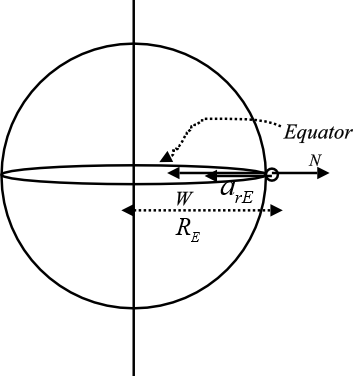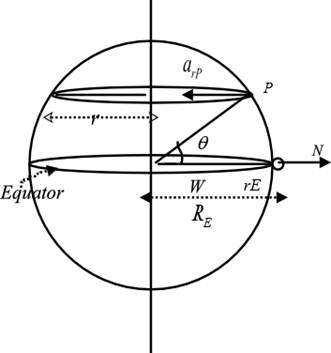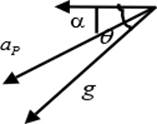
Concept explainers
(a)
The speed and magnitude of the acceleration of a person standing on the equator.
(a)
Answer to Problem 67P
A person standing on the equator has a speed
Explanation of Solution
Given:
Time taken by the Earth to rotate once on its axis,
Radius of the Earth,
Formula used:
The speed
The person on the equator experiences a centripetal acceleration
The total acceleration at the equator is given by,
Calculation:
A person standing on the equator, revolves in a circular path of radius
Calculate speed
All particles fixed on the Earth experience a centripetal force directed towards the center of its circular path. Hence it would experience a centripetal acceleration towards the center of its circular path.
Calculate the centripetal acceleration
Express the acceleration as a percentage of
The total acceleration experienced by the person is given by equation (3).
Conclusion:
Thus, a person standing on the equator has a speed
(b)
The direction of the acceleration vector of the person on the equator.
(b)
Answer to Problem 67P
The acceleration vector of the person is directed towards the center of the Earth.
Explanation of Solution
Introduction:
A person on the surface of the Earth experiences two forces-(i) Gravitational force
An object in order to move in a circular path requires

Figure 1
However, the weight, as felt by the person on the surface of the earth, is equal to the Normal force he experiences.
Hence, the acceleration
Conclusion:
Thus, the acceleration vector of the person on the Equator is directed towards the center of the Earth.
(c)
The speed and magnitude of the acceleration of a person standing at
(c)
Answer to Problem 67P
The speed of the person at
Explanation of Solution
Given:
The latitude where the person was standing,
Radius of the earth at equator,
The speed of the person at equator,
The centripetal acceleration at the equator,
Formula used:
The person at
The speed of person at
His speed at equator is given by
From equations (4) and (5),
The centripetal acceleration at the equator is given by the expression,
The centripetal acceleration at
From equations (4) and (5),
The person also experiences acceleration
The magnitude of the resultant acceleration is determined by using parallelogram law of vectors.
Calculation:
The motion of the person at

Figure 2
From Figure 2, it can be seen that
Use equation (11) in equation (6).
Substitute the value of the variables in the above equation.
Use equation (11) in equation (9) and substitute the values of the variables to calculate the value of
The vector
Substitute the values of variables in equation (10) and calculate the magnitude of the resultant acceleration
Conclusion:
Thus, the speed of the person at
(d)
The angle between the direction of the acceleration at
(d)
Answer to Problem 67P
The angle between the direction of the acceleration at
Explanation of Solution
Given:
The magnitude of centripetal acceleration at
The value of acceleration of free fall,
The latitude where the person was standing,
Formula used:
The direction of the acceleration at the equator is along the horizontal direction parallel to the direction of the centripetal acceleration at
Hence the angle
The vector diagram representing the accelerations is shown below:

Figure 3
This is given by
Calculation:
Substitute the values of the variables in equation (12).
Conclusion:
Thus, the angle between the direction of the acceleration at
Want to see more full solutions like this?
Chapter 3 Solutions
Physics for Scientists and Engineers
- An astronaut is rotated in a horizontal centrifuge at a radius of 5.6 m. How many revolutions per minute are required to produce if the centripetal acceleration has a magnitude of 5.3g? ( g is the gravitational acceleration, g=9.80 m/s2. Your result must include one digit after the decimal point. Maximum of 5% of error is accepted in your answer. Take π=3.14)arrow_forwardIf the magnitude of the acceleration due to gravity on Earth's surface is 9.8 m/s2, what is the magnitude of the acceleration due to gravity at an altitude equal to Earth's radius?arrow_forwardA rotating fan completes 1200 revolutions every minute. Consider the tip of a blade, at a radius of 0.15 m. (a) Through what distance does the tip move in one revolution? What are (b) the tip’s speed and (c) the magnitude of its acceleration? (d) What is the period of the motion?arrow_forward
- A rotating fan completes 1180 revolutions every minute. Consider the tip of a blade, at a radius of 20.0 cm. (a) Through what distance does the tip move in one revolution? What are (b) the tip's speed and (c) the magnitude of its acceleration? (d) What is the period of the motion? (a) Number i Units (b) Number i Unitsarrow_forwardA rotating fan completes 1160 revolutions every minute. Consider the tip of a blade, at a radius of 18.0 cm. (a) Through what distance does the tip move in one revolution? What are (b) the tip's speed and (c) the magnitude of its acceleration? (d) What is the period of the motion?arrow_forwardThe Sun orbits the center of the Milky Way galaxy once each 2.60 × 108 years, with a roughly circular orbit averaging 3.00 × 104 light years in radius. (A light year is the distance traveled by light in 1 y.) Calculate the average speed of the Sun in its galactic orbit in m/s.arrow_forward
- Which of the following quantities are vectors, and which are scalars? Be sure to explain the reasoning for your answer.(a) A bird flies a distance of 20 m.(b) A train is travelling at 100 km/h due north.(c) It takes an athlete 10.37 s to run 100 m.arrow_forwardA stone which tied to a rope is rotated in a circular path with a constant speed V in clockwise direction as given in figure below. The radius R of the circular path is 0.31 m. If the period of the motion is given as T = π /16 s calculate the magnitude of the centripetal acceleration, a. ( Your result must be in m/s 2 and without decimals. Maximum of 2% of error is accepted in your answer.)arrow_forwarda) What is the average speed in kilometers per second of the Earth around the sun, given that the radius of the Earth's orbit is 1.5×108km? b) What is the average velocity of the Earth over a year's time?arrow_forward
- T A force of 4 N makes an angle of radian with the y-axis, pointing to the right. The force acts against the movement of an object 4 along the straight line connecting (2, 2) to (3, 4). (a) Find a formula for the force vector F. F = (b) Find the angle between the displacement direction D = (3 − 2)i + (4 − 2)j and the force direction F. (Round your answer to one decimal place.) 0 = O (c) The work done is F· D, or, equivalently, ||F||||D|| cos(0). Compute the work from both formulas and compare. Narrow_forwardThe formula v = v2.3r models the maximum safe speed, v, in miles per hour, at which a car can travel on a curved road with radius of curvature r, in feet. A highway crew measures the radius of curvature at an exit ramp on a highway as 470 feet. What is the maximum safe speed? For this problem, round your answer DOWN to the nearest whole number. (Think: Why is this type of rounding appropriate for this scenario?) max safe speed =arrow_forwardA skater with mass 66 kg is skating on a horizontal surface at a constant speed 4.2 m/s. There is a ramp ahead, and the skater has just enough speed to make it to the top of the ramp (meaning the speed at the top of the ramp is 0 m/s). What is the height of the ramp in the unit of meters? Use g = 10 m/s2 for the acceleration due to gravity.arrow_forward
 Principles of Physics: A Calculus-Based TextPhysicsISBN:9781133104261Author:Raymond A. Serway, John W. JewettPublisher:Cengage Learning
Principles of Physics: A Calculus-Based TextPhysicsISBN:9781133104261Author:Raymond A. Serway, John W. JewettPublisher:Cengage Learning
